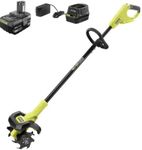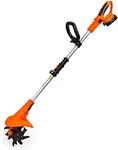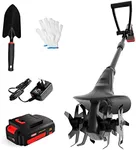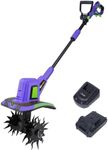Buying Guide for the Best Cordless Electric Tiller
Choosing a cordless electric tiller can make gardening and soil preparation much easier, especially if you want the convenience of not dealing with cords or gas. The right tiller for you depends on the size of your garden, the type of soil you have, and how often you plan to use it. Understanding the key features will help you pick a model that matches your needs and makes your gardening tasks more efficient and enjoyable.Battery Voltage and CapacityBattery voltage and capacity determine how powerful the tiller is and how long it can run before needing a recharge. Higher voltage usually means more power, which is helpful for tougher or compacted soil, while a higher capacity (measured in amp-hours, Ah) means longer run time. For small, soft garden beds, a lower voltage and capacity may be enough, but for larger or tougher areas, look for higher values to avoid frequent recharging and to ensure the tiller can handle the job.
Tilling WidthTilling width is the width of soil the tiller can work in one pass. Wider tillers cover more ground quickly, making them ideal for larger gardens, but they can be harder to maneuver in tight spaces. Narrower tillers are easier to handle in small or raised beds and around plants. Think about the size and layout of your garden to decide if you need a wide or narrow tiller.
Tilling DepthTilling depth refers to how deep the blades can dig into the soil. Deeper tilling is useful for breaking up hard ground or preparing new beds, while shallow tilling is enough for mixing in compost or aerating existing beds. Some tillers have adjustable depth settings, which adds flexibility. Consider what kind of gardening you do most often to choose the right depth range.
Weight and ManeuverabilityThe weight of the tiller affects how easy it is to push and control. Lighter models are easier to handle, especially for smaller users or in tight spaces, but may not dig as deeply or handle tough soil as well. Heavier models can be more effective in hard soil but may be tiring to use for long periods. Think about your physical strength and the type of soil you have to find a balance between power and ease of use.
Blade or Tine DesignThe design and material of the blades (also called tines) affect how well the tiller can cut through soil and roots. Curved or counter-rotating tines can be better for breaking up tough ground, while straight tines are often fine for lighter work. Durable materials like hardened steel last longer, especially if you have rocky or root-filled soil. Match the tine design to the typical conditions in your garden.
Charging TimeCharging time is how long it takes to fully recharge the battery. Shorter charging times mean less waiting between uses, which is helpful if you have a lot of work to do in one day. If you plan to use the tiller for extended periods, look for models with fast charging or consider getting a spare battery so you can swap and keep working.










